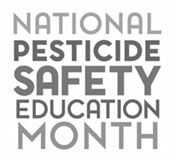Fifth Annual National Pesticide Safety Education Month – February 2022

Figure 1. National Pesticide Safety Education Month has been established to reinforce core principles of
safe pesticide use with many audiences and to raise awareness of and support
for the land-grant university Pesticide Safety Education Programs (PSEPs).
DR. RIC BESSIN
LEXINGTON, KENTUCKY
February is National Pesticide Safety Education month. This is a time to reinforce the core principles of safe and responsible pesticide use with many audiences. Pesticides are key tools used to manage a diverse group of pests, diseases, and weeds. Pesticide safety is just as important with pesticides used around homes as it is on farms and with businesses.
Pesticides as Defined in KY
In Kentucky, pesticides are defined quite widely and the definition includes:
Any substance or mixture of substances to prevent, destroy, control, repel, attract, or mitigate any pest;
Any substances used as plant regulators, defoliants, or desiccants; or.
Any substance used as a spray adjuvant, once they have been mixed with an EPA-registered product.
Some Safety Tips
Safe use of pesticides does not have a simple, one-size-fits-all solution, but here are some basic pesticide safety principles – a starting point for safety from purchase to disposal.
Read the entire pesticide label before purchase and use. You are legally required to read and follow everything on the label except the information about crops or sites that you are not going to treat.
Follow all applicable federal, state, tribal, and local laws and regulations concerning the use of pesticides and personal protective equipment.
Wash your reusable personal protective equipment (PPE) with soap and water after use.
Seek competent advice if there is something you don’t understand on the label or in other applicable laws and regulations.
Transport pesticides in the trunk or truck bed, separate from passengers, groceries, or animal feed, and secure the containers to prevent spills.
Store pesticides in a locked cabinet or secure area, away from food, feed, or personal protective equipment.
Follow all applicable Worker Protection Standards information exchange, notification, posting, and other requirements.
Measure and mix pesticides in a well-ventilated area away from children, pets, toys, and food.
Calibrate and maintain application equipment so that the amount of pesticide applied will be accurate, uniform, and legal.
Keep pesticides on target – use untreated buffers if necessary or delay the application if conditions favor off-target movement due to wind or water.
Identify sensitive areas and organisms that could be affected by the application, and take all necessary precautions.
Do everything possible to prevent spills and leaks, and always have an absorbent material, such as cat litter or sawdust, readily available.
Wash slightly contaminated work clothes separately before re-use, and follow all directions on care and disposal of personal protective equipment.
Dispose of the pesticide properly, as well as any excess spray mixture, empty containers, and contaminated cleanup material and clothing.
Always read and follow all pesticide label requirements as well as all applicable state and federal laws and regulations regarding pesticide use. ∆
DR. RIC BESSIN: Entomology Extension Specialist, University of Kentucky